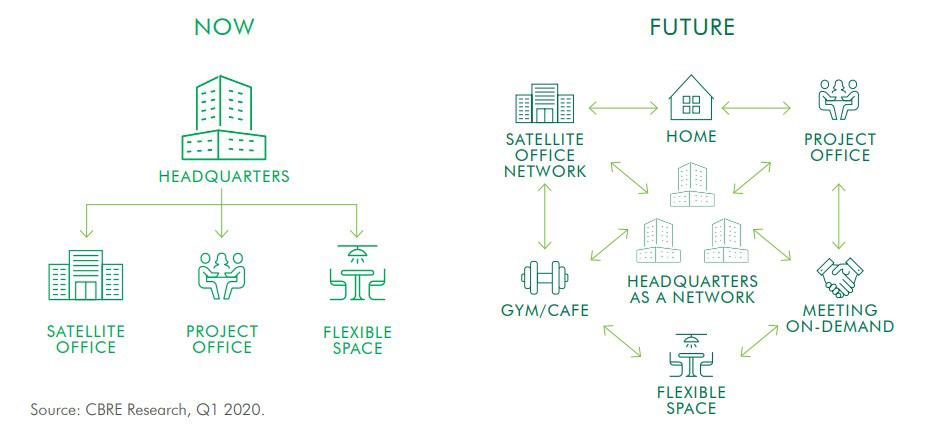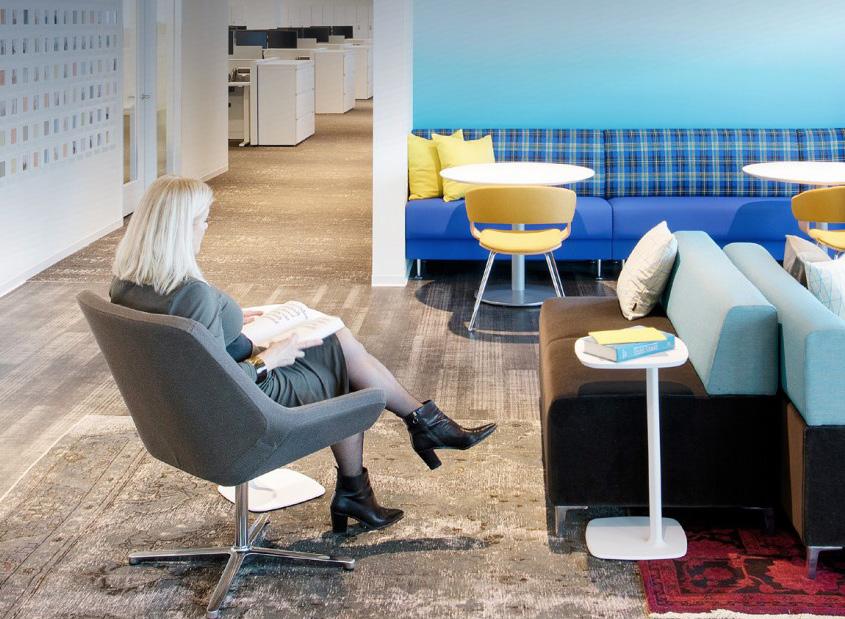
10 minute read
Changing workplace trends and how they will effect the future of the office
August - September 2020 The future of the office
A recent CBRE survey designed to help tenant and investors identify workplace trends after COVID-19 points to permanent changes in real estate
Advertisement
The overall business outlook underpins any real estate decision. At the time of this survey in June 2020, almost half of the respondents believed the business outlook would improve in the next six months, while a quarter thought it would worsen.
More than 40 percent of respondents say the C-suite* will have a strong influence over long-term real estate strategy, which represents an opportunity for a level of strategic decision-making that is different from the past.
This is roughly in accord with CBRE’s baseline economic forecast for a strong global economic recovery to begin in the second half of 2020, limiting global GDP contraction. A return to preCOVID economic growth levels is not expected for several years, the survey report says.
China is already recovering and positive US economic indicators are coming back. Yet recent pockets of resurgent virus outbreaks around the world are increasing the possibility of downside scenarios.
The survey was planned to determine how the COVID-19 pandemic will change the location, design and use of office space.
Most respondents indicated workplace transformation is still trending away from dedicated private space and toward shared collaborative space. This is critical for workplace efficiency and satisfying a more hybrid workforce (in-office and remote working) but there is some uncertainty given the health and safety impacts of COVID-19.
CBRE’s survey reveals a blend of cautious optimism with pragmatic concerns. Executives recognise that reopening workplaces
during an active pandemic is an uncertain endeavour. Beyond the immediate tactical concerns, corporate real estate executives are facing strategic obstacles unlike any seen since the Global Financial Crisis.
Occupiers face major strategic decisions about remote working, urban vs suburban locations and how flexible office space should factor into their plans.
These challenges require an ability to step back from the near-term pressures of reopening workplaces to focus on what’s critical in the long term.
The future role of the office is the biggest question. Even prior to the pandemic, remote working was a well-established trend as employees became less dependent on the physical office to successfully perform their jobs.
In the future employees will have more choice in the spaces they use to accomplish their work, provided they can do so safely. And they’ll have more technology and services to integrate their physical and digital worlds, accelerating many of the design trends that were occurring before COVID-19.
More than 70 percent of survey respondents are confident in formulating a long-term real estate strategy and very few report a total lack of confidence. There is consensus that confidence will build over the next six to 12 months.
Changes may differ from country to country because of varying business cultures, the report says, but one thing seems certain worldwide: COVID-19 will accelerate the transformation of many offices with regard to technological advancements, workplace health and safety, and employee-centric policies.
Office occupancy and rental rates will be impacted to varying degrees depending on market fundamentals although strategies for more or new space are largely on hold.
Some of the key aspects of real estate portfolio decision-making have risen in prominence during the COVID-19 outbreak: urban vs suburban locations, core vs flexible locations and now more than ever home vs physical office work.
These complex decisions are influenced by near-term health and safety concerns, corporate culture, employee preferences and leadership
biases.
While a more distributed workforce may reduce the risk of having a single headquarters building, corporate culture and connectivity could be adversely affected in unplanned and undesirable ways. A more distributed network of locations may offer employees shorter commute times but at greater capital and operating cost.
Employees who spent at least some of their time working remotely were a moderately sized but high-growth segment of the workforce even before COVID-19. Now, survey respondents indicate a significant acceleration of this trend and therefore it could be the single biggest lasting change in real estate strategy.
In the pre-COVID environment, 63 percent of respondents indicated their company had no full-time remote work; today, only 10


percent expect no remote work policies in the future.
Remote work is often considered as an all-or-nothing proposition where an employee is either full-time remote or full-time in the office.
However, CBRE’s workplace research over the past several years shows that employees prefer having both options as a hybrid approach. In theory, a hybrid workforce works fluidly between remote locations and a physical office provided by the employer.
Employees can choose which location will be most productive for them without the expectation to be in any one place five days a week.
While one-quarter of respondents indicated that their employees could choose full-time remote work in the future, 61 percent indicated that they will offer their employees this hybrid arrangement.
This signals that employers will foster more trust among their employees by offering them more choice on where they work each day. Overall, we see a future where employers maintain ultimate decision rights over allowing employees a choice of full-time remote work options.
Large corporate occupiers have traditionally favored urban locations for their accessibility, amenities and business clustering. But these highly dense mass-transit-oriented urban cores have been hard hit by the COVID-19 pandemic, causing lingering health concerns about returning to the office.
So, is the wind changing in a suburban direction?
There currently does not seem to be much sentiment to move out of high-density urban cores. The role of the city centre headquarters likely won’t disappear, but city locations may serve as a more transient cultural base for employees in a broader real estate footprint that may include an employees’ home working environment and satellite locations near workforce population clusters,
The high-growth flexible office space market has slowed due to the COVID-19 pandemic and an aggressive over-expansion of some flex providers. Nevertheless, occupiers are still considering flexible office space as a stopgap to delays in new construction or as an alternative to athome work.
No capital commitment and no risk of being stuck with unneeded space is a compelling combination when the future is even more uncertain than usual.
Companies with flexible office space have been able to shed it relatively quickly as part of their downsizing strategies - 73 percent of survey respondents say flexible office space will be a part of their long-term real estate strategy.
Flexible office space providers will emerge from this recessionary period as stronger and better regarded than before.
Landlords are recognising that they can play a larger role in the success of this market by offering their own flexible space solutions or in partnerships with third-party providers. Additionally, the marketing of flexible office
As companies plan for increased workforce mobility, how the workplace satisfies that mobility while remaining efficient and effective becomes an important calculation. This might be a relatively simple calculation for employees who will become full-time remote. If employees can choose a more hybrid way of working—as research suggests is their desire—the office design, the services provided and the supporting technology all must be carefully considered.

As worker flexibility increases, so too must the flexibility of the office that supports them. Research indicates that as more workers adopt a hybrid way of working, a common way to increase space utilization and efficiency is to use a shared-space model.
Most respondents indicated that before COVID-19 the future of workplace design would feature less enclosed The
“Free address” means that employees are not assigned to an individual desk and instead share a network of spaces (offices, workstations, collaboration space, focus rooms and amenities). Without the need to exclusively assign desks to employees, occupiers can have fewer desks than people and rebalance the workplace toward serving a more dynamic population. Free addressing likely will increase as companies monetize their shared space to offset increased real estate and occupancy costs.
In the post-shutdown environment, workers enabled by technology and emboldened by their experience in working away from the office will have increased expectations for the office to which they return. The flexibility to manage work routines between a network of places (including home) will lead the most sought-after employees to be discerning about where they work and why.
Working away from the office has proven successful but has decreased social interaction, networking, mentoring and collaboration, and at times strained work/life balance—all critical elements of career growth and organizational productivity.
The function of the office will shift away from traditional work processes and oversight to more collaborative, educational and social needs of a growing hybrid workforce.
This is not much different from the evolution of the office before COVID-19, where the workplace was seen as a primary facilitator of collaboration, innovation and productivity. It is now more critical than ever for companies to take this journey as the workforce is on an accelerated path of change. The role of corporate real estate executives will be elevated to meet these new workforce demands and navigate a more complex work environment.
This article was extracted from a survey report prepared by CBRE Research.
*C-suite refers to the executive-level managers within a company. Common c-suite executives include chief executive officer (CEO), chief financial officer (CFO), chief operating officer (COO), and chief information officer (CIO).
August - September Sponsored Article 2020 Quality face mask with replaceable filters
Covering our faces on the way to work, in a work environment and during activities has become a common sight in cities worldwide
While there is no offer 98 percent filtration Health Professor Michael layers of water repellent such thing as a efficiency via a replaceable Baker says virtually every fibre. Filters are non-reperfect mask, 3-Layer Filter, so lightcountry in the world has usable and can last up to says US physician Dr James weight it allows a wearer to masks as part of their key one day. The unit comes Hamblin: “Surgical masks breathe freely. It is adjustmeasures to combat Covid with five replaceable and come closest to perfect for able from the back of the and a resurgence of cases. approved filters. New filters this moment. head to ensure an individ“Every New Zealander come in packs of 30.
“They are feather-light, ual fit designed just for you should have a mask at Surgical masks are classibreathable, and electrowithout creating a pressure home and know how to use fied into three types: statically charged to catch point around the ears comit and when to use it. Masks Type I, which has bacteviruses without blocking air. mon to other masks. are a great precaution to ria filtering effectiveness
“They seal tightly around Made in Germany from have available,” he says. ≥95%, your face, but not so tightly three combined layers, the BUFF® meets surgiType II, which has bacthat they cause injuries filter, which is designed cal mask standard: AS teria filtering effectiveness when worn all day,” he says. specifically to fit the Buff NZS 1716 2012 and EN 98% and Type IIR, which
The BUFF® Filter Mask Filter Mask, is glue and 14683:2019 Type I & II with has bacteria filtering effecticks all the right boxes. latex free. one layer of melt-blown tiveness ≥ 98% but is also Made in Spain, the masks Otago University Public Nano fibre enclosed by two resistant to liquids.
BUFF® Filter Mask
NEW PRODUCT 2020
KEY ADVANTAGES:
Reusable mask made from CoolNet UV+® fabric which gives it a great lightness and breathability.
Its adjustable and light design makes it very comfortable, even during long periods of usage.
It includes a system of 3-layer replaceable filters made in Germany by Ahlstrom-Munksjö.

98% Filters provide 98% Bacterial Filtration Efficiency (BFE) and meet mask standard: EN14683:2019 Type I & II. surgical
Includes HeiQ V-Block TM NPJ03 NPJ03 antibacterial treatment applied o n the filter inside pocket.












